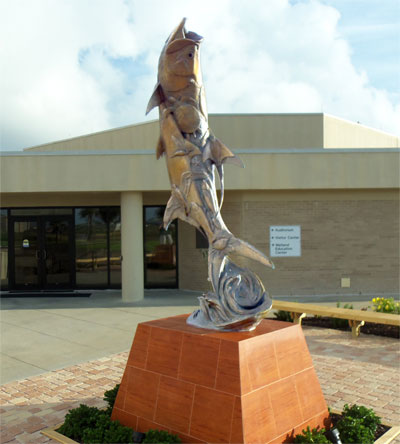Free of Charge
Hours of Operation: Tuesday-Saturday from 10 a.m. - 4 p.m. (Closures may occur with University holidays.)
Location: 855 East Cotter Ave. (on the way to the beach) Maps & Directions
The newly renovated Patton Center for Marine Science Education features eight large aquaria and engaging interactive displays, that provide opportunities for people of all ages to learn about the local marine life and the research that is conducted at the University Marine Science Institute and its Mission-Aransas Reserve program.
The Center was severely damaged by Hurricane Harvey in 2017 and was renovated with support from the University of Texas at Austin, the National Oceanic and Atmospheric Administration (Continuing Appropriations Act, 2018 and Supplemental Appropriations for Disaster Relief Requirements Act, 2017), and philanthropists Bobby and Sherri Patton. The space has since been transformed into a bright and dynamic facility to teach about the wonders of the local marine ecosystems. The Center was designed by Turner | Ramirez Architects and constructed by Beecroft Construction. Both firms are based in Corpus Christi, Texas.
The Center is free of charge and will be open Tuesday-Saturday 10 a.m. - 4:00 p.m. The Center will include programs such as keeper chats and fish-feeding demonstrations.
Are you interested in booking a program for groups of 10 or more? Please complete the Visiting Group Request form to ensure we have your request and contact information. Questions? Contact us at This email address is being protected from spambots. You need JavaScript enabled to view it..

Celebrating the Texas Gulf Marine Environment in Art
“ Interdependency,” a sculpture by renowned artist Kent Ullberg, adorns the main entrance of the University of Texas Marine Science Institute. From a distance, “Interdependency” is a 10-foot long tarpon leaping out of the sea, but a closer look reveals more than 50 marine plants and animals that fuse together to create the giant fish.
Interdependency,” a sculpture by renowned artist Kent Ullberg, adorns the main entrance of the University of Texas Marine Science Institute. From a distance, “Interdependency” is a 10-foot long tarpon leaping out of the sea, but a closer look reveals more than 50 marine plants and animals that fuse together to create the giant fish.
The sculpture, which was unveiled on July 21, 2012, was made possible by a generous donation from the Jack and Valerie Guenther Foundation.
Ullberg decided to depict a tarpon because it is a symbol of Port Aransas (which, until 1910, was named Tarpon, Texas) and a symbol of the Gulf of Mexico marine environment. Forming the tarpon from a diverse array of marine life was inspired by the famous Renaissance painting Vertumnus by Giuseppe Arcimboldo, which hangs in the national museum in Ullberg’s native Sweden. Arcimboldo’s 1590 oil painting uses fruits, vegetables, grains, and flowers to create a portrait of Emperor Rudolf II of the Holy Roman Empire. Just as in the painting, Ullberg’s tarpon comes together as a fusion of sea life that ranges from microscopic plankton and seaweed to fishes, whales, and birds.
Ullberg described “Interdependency” as the most challenging individual sculpture of his career. While incorporating so many different plants and animals and making sure they all were scientifically correct, he had to maintain the form of the tarpon. But as he puts it, the Institute got “50 sculptures for the price of 1.”
Ullberg hopes his work will be fun and educational. Children can make a game of finding each of the different creatures in the sculpture. They will also learn something about the interdependency of marine life when they see the osprey carrying a mullet in its talons, a crab nipping the tail of the redfish, or the remora attached to the shark.
The sculpture, which was unveiled on July 21, 2012, was made possible by a generous donation from the Jack and Valerie Guenther Foundation.
Related information:
University of Texas College of Natural Sciences News Release (July 23, 2012)
Port Aransas South Jetty newspaper (July 26, 2012)








